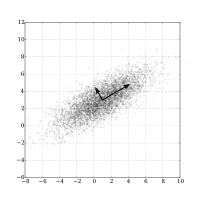
Photo from wikipedia
It is known that brain can create a sparse representation of the environment in both sensory and mnemonic forms (Olshausen & Field, 2004). Such sparse representation can be combined in… Click to show full abstract
It is known that brain can create a sparse representation of the environment in both sensory and mnemonic forms (Olshausen & Field, 2004). Such sparse representation can be combined in downstream areas to create rich multisensory responses to support various cognitive and motor functions. Determining the components present in neuronal responses in a given region is key to deciphering its functional role and connection with upstream areas. One approach for parsing out various sources of information in a single neuron is by using linear blind source separation (BSS) techniques. However, applying linear techniques to neuronal spiking activity is likely to be suboptimal due to inherent and unknown nonlinearity of neuronal responses to inputs. This letter proposes a nonlinear sparse component analysis (SCA) method to separate jointly sparse inputs to neurons with post summation nonlinearity, or SCA for post-nonlinear neurons (SCAPL). Specifically, a linear clustering approach followed by principal curve regression (PCR) and a nonlinear curve fitting are used to separate sources. Analysis using simulated data shows that SCAPL accuracy outperforms ones obtained by linear SCA, as well as other separating methods, including linear independent and principal component analyses. In SCAPL, the number of derived sparse components is not limited by the number of neurons, unlike most BSS methods. Furthermore, this method allows for a broad range of post-summation nonlinearities that could differ among neurons. The sensitivity of our method to noise, joint sparseness, degree, and shape of nonlinearity and mixing ill conditions is discussed and compared to existing methods. Our results show that the proposed method can successfully separate input components in a population of neurons provided that they are temporally sparse to some degree. Application of SCAPL should facilitate comparison of functional roles across regions by parsing various elements present in a region.
Journal Title: Neural Computation
Year Published: 2019
Link to full text (if available)
Share on Social Media: Sign Up to like & get
recommendations!